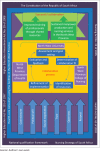A model of collaboration between nursing education institutions in the North West Province of South Africa
- PMID: 29041782
- PMCID: PMC6091765
- DOI: 10.4102/curationis.v40i1.1670
A model of collaboration between nursing education institutions in the North West Province of South Africa
Abstract
Background: Professional nursing in South Africa is obtained through a 4-year diploma offered at nursing colleges, or a 4-year degree in universities, and the South African Nursing Council (SANC) registered both for professional nursing. New SANC legislation now requires a bachelor's degree for registration as professional nurse.
Objectives: The aim of the study was to explore and describe perceptions of nurse educators and stakeholders to develop a model of collaboration for joint education and training of nursing professionals by colleges and universities through a bachelor's degree.
Method: A mixed methods approach was used to explore perceptions of nurse educators utilising a questionnaire, and perceptions of other nurse training stakeholders through interviews, about a model of collaboration between the college and the university.
Results: Themes that emerged from the interviews included identifying collaboration goals, establishing a conducive environment, maximising exchange of resources, role clarification and perceived challenges. Quantitative results showed high agreement percentages (84.13%-100%) on most basic concepts and themes. A model of collaboration was developed indicating a framework, agents, recipients, procedure, dynamics, and terminus.
Conclusion: A model of collaboration was acceptable to the majority of nurse education stakeholders. Other implications are that there was a need for the improvement of scholarship among nurse educators and clinical mentors, sharing rare skills, and addressing perceived challenges.
Conflict of interest statement
The authors declare that they have no competing interests and no financial or personal relationships that may have inappropriately influenced them in writing this article.
Figures





Similar articles
-
A model of collaboration for the implementation of problem-based learning in nursing education in South Africa.Curationis. 2017 Aug 28;40(1):e1-e10. doi: 10.4102/curationis.v40i1.1765. Curationis. 2017. PMID: 28893071 Free PMC article.
-
Mission possible: twenty-five years of university and college collaboration in baccalaureate nursing education.J Nurs Educ. 2014 Oct;53(10):580-8. doi: 10.3928/01484834-20140922-04. J Nurs Educ. 2014. PMID: 25275991
-
Challenges in conducting qualitative research among nurse educators.J Pak Med Assoc. 2023 Mar;73(3):511-514. doi: 10.47391/JPMA.6087. J Pak Med Assoc. 2023. PMID: 36932751
-
The journey toward geriatric excellence in a non-research-intensive university.J Prof Nurs. 2006 Mar-Apr;22(2):84-90. doi: 10.1016/j.profnurs.2006.01.011. J Prof Nurs. 2006. PMID: 16564472 Review.
-
Experiences of Nurse Educators Regarding the R171 Nursing Curriculum in North-West Province, South Africa.SAGE Open Nurs. 2024 Dec 13;10:23779608241293700. doi: 10.1177/23779608241293700. eCollection 2024 Jan-Dec. SAGE Open Nurs. 2024. PMID: 39676902 Free PMC article. Review.
Cited by
-
Positioning public nursing colleges in South African higher education: Stakeholders' perspectives.Curationis. 2019 May 23;42(1):e1-e11. doi: 10.4102/curationis.v42i1.1885. Curationis. 2019. PMID: 31170798 Free PMC article.
-
Challenges in implementing new nursing qualifications (Regulation 174) in South African public nursing colleges: Principal perspectives.Curationis. 2025 Jun 26;48(1):e1-e10. doi: 10.4102/curationis.v48i1.2544. Curationis. 2025. PMID: 40599044 Free PMC article.
-
A phenomenographic study exploring the conceptions of stakeholders on their teaching and learning roles in nursing education.BMC Med Educ. 2022 May 26;22(1):404. doi: 10.1186/s12909-022-03392-w. BMC Med Educ. 2022. PMID: 35619092 Free PMC article.
-
Nurse educators' experiences regarding management practices at a nursing education institution.Health SA. 2022 Nov 21;27:1935. doi: 10.4102/hsag.v27i0.1935. eCollection 2022. Health SA. 2022. PMID: 36483494 Free PMC article.
References
-
- Andale , 2014, ‘Cronbach Alpha: Simple definition, use and interpretation’, viewed n.d., from http://www.statisticshowto.com/cronbachs-alpha-spss/
-
- Brink H., Van der Walt C. & Van Rensburg G, 2012, Fundamentals of research methodology for health care professionals, 2nd edn, Juta and Company Ltd., Cape Town.
MeSH terms
LinkOut - more resources
Full Text Sources
Other Literature Sources
